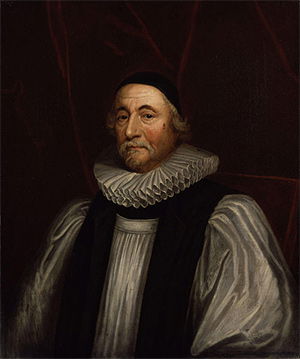The Death of Archbishop Ussher
Richard Cavendish marks the demise of an important Renaissance figure, on March 20th, 1656.
 Renaissance scholars tried manfully to date the events of the Old Testament on the ‘begat’ basis, by counting back through the successive generations recorded in scripture. The most impressive chronology was produced in the 1650s by James Ussher, Archbishop of Armagh. Believing in the literal truth of the Bible and assuming that a biblical year would have had 365 days, he dated Noah’s Flood to 2349 BC and worked back from there to calculate that God created the world in October 4004 BC. Ussher explained that the date depended on which text of the Old Testament was used. The time from the Flood back to the Creation, according to his calculations, was 1,656 years in the Hebrew text, 1,307 years in the Samaritan Pentateuch and 2,262 years in the Ethiopic text. He took the Hebrew text as authoritative and believed that 4004 BC would prove to be either correct or at least not far off.
Renaissance scholars tried manfully to date the events of the Old Testament on the ‘begat’ basis, by counting back through the successive generations recorded in scripture. The most impressive chronology was produced in the 1650s by James Ussher, Archbishop of Armagh. Believing in the literal truth of the Bible and assuming that a biblical year would have had 365 days, he dated Noah’s Flood to 2349 BC and worked back from there to calculate that God created the world in October 4004 BC. Ussher explained that the date depended on which text of the Old Testament was used. The time from the Flood back to the Creation, according to his calculations, was 1,656 years in the Hebrew text, 1,307 years in the Samaritan Pentateuch and 2,262 years in the Ethiopic text. He took the Hebrew text as authoritative and believed that 4004 BC would prove to be either correct or at least not far off.
Other scholars picked over the calculations. The Cambridge academic John Lightfoot dated the creation of Adam to precisely 9am on October 23rd, 4004 BC. Ussher’s dates were generally accepted in the English-speaking world and were printed in the margins of some editions of the Authorised Version of the Bible. The pioneers of modern geology would find themselves forced to argue strenuously that the Earth was older than Ussher had supposed.
James Ussher was born in 1581 in Dublin, to a well-to-do family of English descent on both sides. His younger brother Ambrose would become a distinguished scholar of Hebrew and Arabic, and their Uncle Henry was Archbishop of Armagh from 1595. Strangely, according to his chaplain and biographer Nicholas Bernard, James was taught to read by two spinster aunts who were both blind. He went to the new university in Dublin, Trinity College, and in his twenties was appointed professor of divinity there. A convinced Calvinist Protestant and resolute anti-Catholic, he was made Bishop of Meath in 1620, translated to Armagh in 1625 and successfully opposed attempts to revive the ancient Irish language for use in church services. He wrote extensively on theology and ecclesiastical history and his account of the early Celtic Irish church, which he maintained had been fundamentally protestant, commanded respect down into the twentieth century.
From 1640 Ussher lived in England, involved in English politics. He was liked and admired by both Charles I and Oliver Cromwell, and he watched the execution of Charles I from a distance, but fainted before the axe fell. His great chronological work, the Annals of the Old and New Testaments, appeared in two parts in 1650 and 1654.
Two years later, with his sight failing and finding it hard to write, he went to stay with an old friend, the Countess of Peterborough, in her house in Reigate in Surrey. On March 19th the Archbishop was taken with a fierce pain in his side at supper and retired to bed. It became clear that he had little time left and after praying with the countess’s chaplain and saying a regretful farewell to the countess herself, he died at about one o’clock in the afternoon the next day, at the age of seventy-five.
His last words were reported as ‘O Lord forgive me, especially my sins of omission.’ The body was embalmed and the plan was to bury him in Reigate, but Cromwell insisted on a state funeral and Ussher was laid to rest in Westminster Abbey, in the chapel of St Erasmus, on April 17th.




